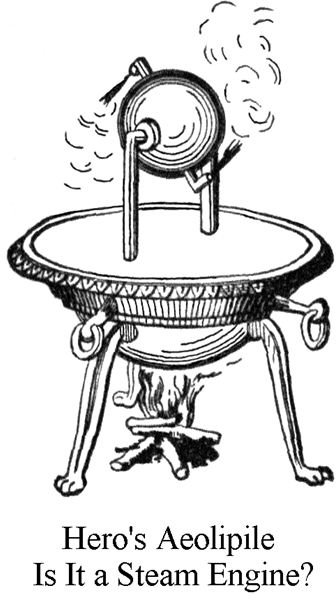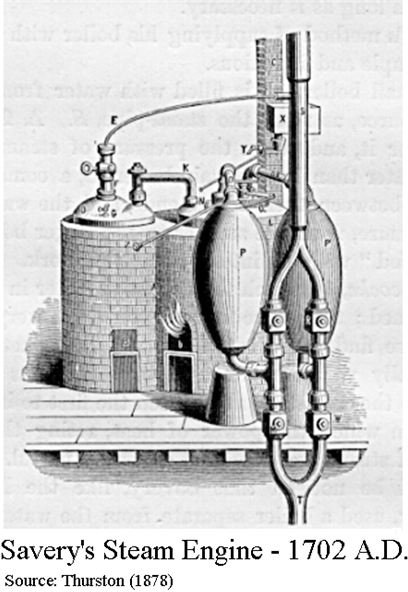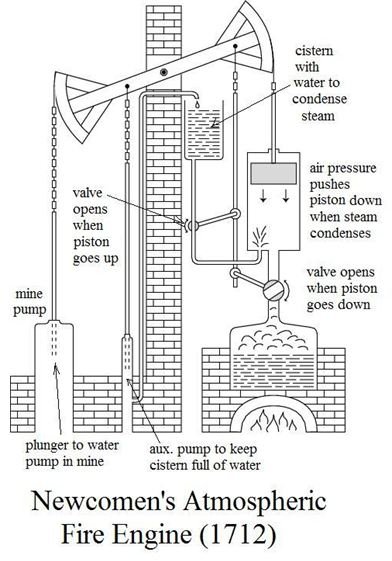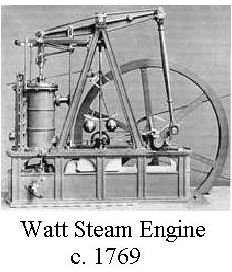Overview
The question, ‘Who invented the first steam engine and in what year ?’ is an interesting one, because the answer is so fuzzy. Heron (also called Hero) is sometimes credited as the one who invented the steam engine at about 100 A.D, because he built a device which rotated by jet power from exhausting steam. Another candidate,
Thomas Savery, patented a means of pumping water out of coal mines by steam power in 1698. In about 1712, Thomas Newcomen, working with Thomas Savery, invented an atmospheric steam engine as an improved device for pumping water from coal mines. In approximately the last quarter of the 18th century, James Watt invented several improvements to the steam engine that made it into a device that could be used for power in factories. Each of these candidates for recognition as the one who invented the steam engine will be discussed in the following sections of this article, then one will be identified as the best candidate.
Heron of Alexandria and his Aeolipile

The man credited with invention of the aeolipile, identified as either ‘Hero’ or ‘Heron,’ was a Greek who lived in Alexandria, Egypt, from about 10 to 70 A.D. A diagram of the aeolipile built by Hero is shown at the left. In this device, steam was generated by a fire under a closed pot of water. The steam entered the ball through the vertical tubes connecting the ball to the heated pot. The steam escaped from the ball through the tubes that are bent at a 90o angle, so that the jet action from the exhausting steam caused the ball to rotate.The rotational motion could have been put to productive use driving machinery, but there is no evidence that it was put to that use. It seems that it was mostly a toy or a demonstration that was used in temples.
Thomas Savery uses Steam to Remove Water from Mines
Another possible answer to the question, ‘Who invented the first steam engine and in what year ?’ is Thomas Savery in 1698.

That’s the year in which Savery (1650 – 1715), an English military engineer, patented a device to remove water from coal mines using steam. A 1702 version of Savery’s ‘fire engine,’ as he called it, is shown in the illustration at the right. This apparatus could draw water from a mine by alternately sending steam from a boiler into a vessel containing water, thus forcing water out, and cooling the steam to condense it, creating a suction to draw water into the vessel from the mine. It was said to be able to raise water as much as 24 feet. Since Savery’s device had no moving parts, it is often not considered to be a steam ‘engine.’
Thomas Newcomen and a Steam Engine to Remove Water from Mines

Thomas Newcomen (1663 – 1729) is a third candidate for recognition as ‘the one who invented the steam engine .’ He built the first atmospheric steam engine as an improvement over Savery’s device for removing water from coal mines. Newcomen’s steam engine is shown in the illustration at the left. His was the first ‘steam engine’ with moving parts and mechanisms, and thus is considered by some to be the first actual steam engine. His steam engine had a pump plunger and cylinder immersed in the water down in the mine. The pump plunger was moved up and down to pump water by a piston and cylinder above a fire box and steam generator. The cylinder was alternately filled with steam to move the piston up and then sprayed with cold water to condense the steam so that atmospheric pressure pushed the piston down. The downward position of the piston allows steam to enter the cylinder again and the process is repeated.
Thomas Watt and Major Improvements to the Steam Engine
The fourth answer we’ll consider to the question, ‘Who invented the first steam engine and in what year ?’ is James Watt in the mid to latter part of the 18th century. Watt (1736 – 1819) is the

one with the greatest name recognition among the inventors being considered here. One reason for his name recognition is use of the watt (which was named after him) as a unit of power. Watt is sometimes recognized as the one who invented the steam engine because he made major improvements to the Newcomen steam engine, converting it into a useable source of power for machinery in factories, thus helping to ‘jump start’ the industrial revolution. Some of the more important innovations that Watt added to the steam engine were i) a separate condenser that increased the efficiency for conversion of heat to mechanical energy by about fourfold, ii) a crankshaft and flywheel to convert the ‘up and down’ motion to a rotating shaft, and iii) a governor to keep the speed of the engine from going out of control. The image at the right is a depiction of a Watt steam engine of about 1769.
Summary
So, who invented the first steam engine and in what year? There are still at least four feasible answers. If you consider the aeolipile built by Hero in the first century A.D. to be a steam engine, because it made a ball rotate using steam power, even though it did no useful work, then Hero is the one who invented the steam engine.
If you consider it necessary that a steam engine does useful work, then Thomas Savery’s ‘fire engine’ that was patented in 1698 to raise water out of coal mines could be considered to be the first steam engine. If a ‘steam engine’ must have moving parts and do useful work, then Thomas Newcomen, who built a more advanced ‘fire engine’ that operated with steam power to raise water from mines, would be considered the one who invented the steam engine.
Finally, Thomas Watt, who developed the steam engine so that it was capable of providing power to machinery in factories, in the latter quarter of the eighteenth century, is considered to be the one who invented the steam engine by some.
My vote is for Thomas Newcomen as the inventor of the steam engine in about 1712, because his ‘steam engine’ was the first with moving parts that did useful work.
For more contemporary steam engine information, check out Bright Hub articles about such topics as green steam engines and the use of steam on ships.
References
1. Thurston, Robert H., A History of the Growth of the Steam Engine, D. Appleton and Company, 1878, https://www.history.rochester.edu/steam/thurston/1878
2. Internet Modern History Sourcebook, https://www.fordham.edu/halsall/mod/modsbook14.html

No comments:
Post a Comment
No adult content please.
Articles accepted having references.
No advertisement accepted.